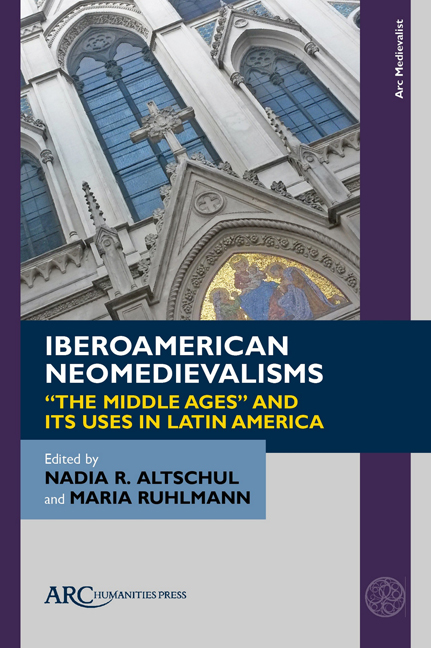Book contents
- Frontmatter
- Contents
- List of Illustrations
- Chapter 1 Postcolonizing Neomedievalism:An Introduction
- Chapter 2 The Criollo Invention of the Middle Ages
- Chapter 3 A Militant and Peasant-Based Medieval History in Brazil: Fanning the Spark of Hope
- Chapter 4 Neomedievalism and the Hagiography of Valdemiro Santiago: Neopentecostal Sanctification
- Chapter 5 The “Middle Ages” in the Brazilian Presidential Elections of 2018: The Left, the Right, and the Centre
- Chapter 6 Averroes in Mid-Colonial and Inter-Imperial Cordoba
- Chapter 7 Hypermedievalizing and De-Medievalizing Dante: Leopoldo Lugones’s and Jorge Luis Borges’s Rewritings of Inferno V
- Chapter 8 Borges and Kennings
- Chapter 9 Memory, Desire, and Sexual Identity in Manuel Mujica Lainez’s El unicornio
- Chapter 10 Rewriting and Visualizing the Cid: The Reconstruction of Medieval Gender and Race in Argentinian Graphic Novels
Chapter 4 - Neomedievalism and the Hagiography of Valdemiro Santiago: Neopentecostal Sanctification
Published online by Cambridge University Press: 18 November 2023
- Frontmatter
- Contents
- List of Illustrations
- Chapter 1 Postcolonizing Neomedievalism:An Introduction
- Chapter 2 The Criollo Invention of the Middle Ages
- Chapter 3 A Militant and Peasant-Based Medieval History in Brazil: Fanning the Spark of Hope
- Chapter 4 Neomedievalism and the Hagiography of Valdemiro Santiago: Neopentecostal Sanctification
- Chapter 5 The “Middle Ages” in the Brazilian Presidential Elections of 2018: The Left, the Right, and the Centre
- Chapter 6 Averroes in Mid-Colonial and Inter-Imperial Cordoba
- Chapter 7 Hypermedievalizing and De-Medievalizing Dante: Leopoldo Lugones’s and Jorge Luis Borges’s Rewritings of Inferno V
- Chapter 8 Borges and Kennings
- Chapter 9 Memory, Desire, and Sexual Identity in Manuel Mujica Lainez’s El unicornio
- Chapter 10 Rewriting and Visualizing the Cid: The Reconstruction of Medieval Gender and Race in Argentinian Graphic Novels
Summary
In 1998 Valdemiro Santiago de Oliveira founded the Igreja Mundial do Poder de Deus or Worldwide Church of God's Power (hereafter wcgp) and has been its leader ever since. The goal of this study is to foreground the “medieval” elements found in his religious discourse. I aim to show how his book O grande livramento (hereafter referred to as The Great Deliverance) uses discursive features commonly found in medieval hagiographies to promote the sacralization of his image and, consequently, develops his own hagiography. The issue goes beyond the use of the Middle Ages as a pretext to discuss topics from the present. The production and circulation of a religious discourse that harks back to early Christianity can have a symbolic effect in a country with deep Catholic influences like Brazil.
The WCGP is a Neopentecostal church that uses hagiographical discourse drawn from the Middle Ages as a way to sacralize its leader. Here, our focus is not on intentionality but rather on the hypothesis that in a culture such as Brazil's that is marked by Christianity the use of a rhetorical strategy based on a medieval-inspired narrative confers legitimacy on those who construct such narratives. Therefore, our theoretical approach employs neomedievalism, defined as the appropriation and reception of the Middle Ages. According to Francis Gentry and Ulrich Müller, one of the four distinct models of medieval reception is precisely the “political-ideological reception of the Middle Ages” which means that “medieval works, themes, ‘ideas’ or persons are used and ‘reworked’ for political purposes in the broadest sense, i.e., for legitimization or for debunking.”
In this study, our primary focus will be the medievalizing political and ideological appropriation used by Santiago de Oliveira to legitimate his image in The Great Deliverance. Valdemiro presents himself as a man who was persecuted and became a “martyr”— like the early Christians—thriving both religiously and financially due to his privileged relationship with the sacred. Valdemiro, after all, succeeded in becoming an “Apostle” of his church and according to Forbes Magazine in 2013 was considered the second wealthiest religious leader in Brazil with an estimated net worth at US$220 million.
A Brief Overview of Valdemiro and the WCGP
Although some facts about Valdemiro can be found on the official website of his church, and he has published several books, not much information can be found about his life.
- Type
- Chapter
- Information
- Iberoamerican NeomedievalismsThe Middle Ages' and Its Uses in Latin America, pp. 63 - 80Publisher: Amsterdam University PressPrint publication year: 2023

